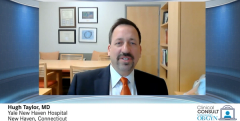
Using Aromatase Inhibitors for the Treatment of Endometriosis
An expert reproductive endocrinologist comments on the patient selection of aromatase inhibitors and the role of selective estrogen receptor modulators (SERMs) for endometriosis treatment.
Episodes in this series

Robert N. Taylor, MD, PhD: There are other medications that we’ve not talked about very much so far that should be mentioned; one of these is the aromatase inhibitors. Again, as I’ve mentioned, if estradiol is the culprit in endometriosis growth and pain, then inhibiting estradiol production [is important] and most directly that can be done by preventing the conversion of testosterone to estradiol by inhibiting the enzyme aromatase. Aromatase inhibitors have been used in this setting also quite effectively. I do believe that there’s a special patient population for whom aromatase inhibitors are most useful, in my own experience. That was based on the discovery from several years ago by Serdar Bulun, [MD,] who identified the endogenous expression of aromatase in endometriosis lesions, per se. Now, aromatase is expressed in the brain, and in adipose tissue, and in the ovary, in particular, but in endometriosis, it’s also expressed. This allowed menopausal women who were estrogen depleted to convert their circulating androgens into estrogen, into estradiol. Dr Bulun suggested that in these menopausal women, treatment with an aromatase inhibitor could be quite effective and demonstrated that this was a great way to reduce the symptoms and the size of those lesions that had broken through by virtue of their ability to generate their own estrogen production.
I think that the menopausal patient is the ideal one for aromatase inhibitors because in cycling women who have normal premenopausal hypothalamic-pituitary-ovarian function, aromatase inhibitors can cause an increase in gonadotropin secretion and formation of ovarian cysts. Thus, this could be a complication and may be one of the reasons in that patient population, the younger patient population, where aromatase inhibitors aren’t as effective as therapeutics for endometriosis pain. A similar phenomenon was also noted with the use of the selective estrogen receptor modulator [SERM] raloxifene. A study from the early 2000s that came out of the NIH [National Institutes of Health], doctors Pam Stratton, [MD,] and Jim Segars, [MD,] were involved in those particular studies, looked at postoperative pain management in a placebo-controlled study of raloxifene, one of the selective estrogen receptor modulators. They found that the women who were on the active drug had recurrence of their pain earlier and in a more severe fashion than women on placebo. It wasn’t investigated extensively, but it appears that the raloxifene had a similar effect to stimulate gonadotropins in the pituitary that might have exacerbated the endometriosis itself, perhaps through ovarian production of estrogen. This hasn’t been clearly sorted out. But I wouldn’t be surprised if a similar phenomenon as we’ve described for the aromatase inhibitors might be one of the reasons that SERMs haven’t worked very well either in premenopausal women with endometriosis.
Transcript Edited for Clarity
Newsletter
Get the latest clinical updates, case studies, and expert commentary in obstetric and gynecologic care. Sign up now to stay informed.






